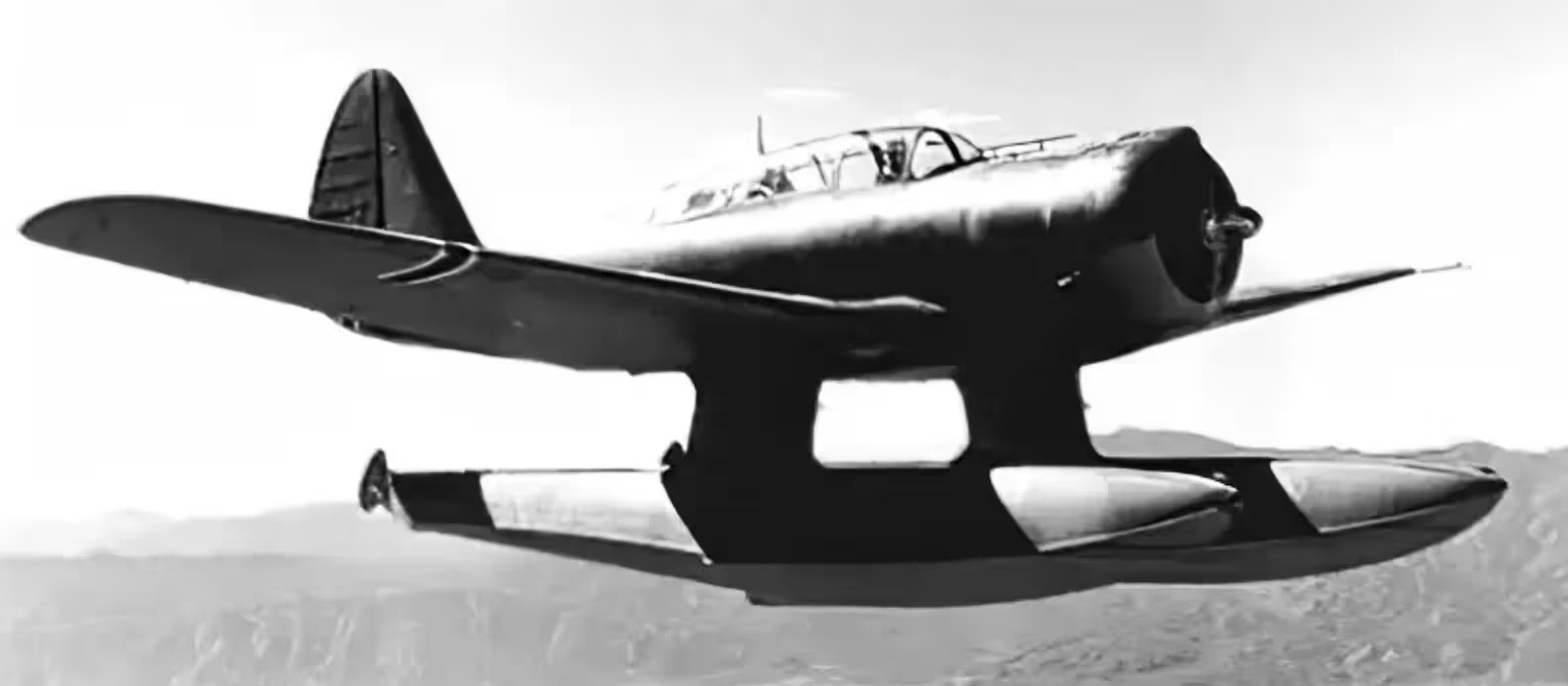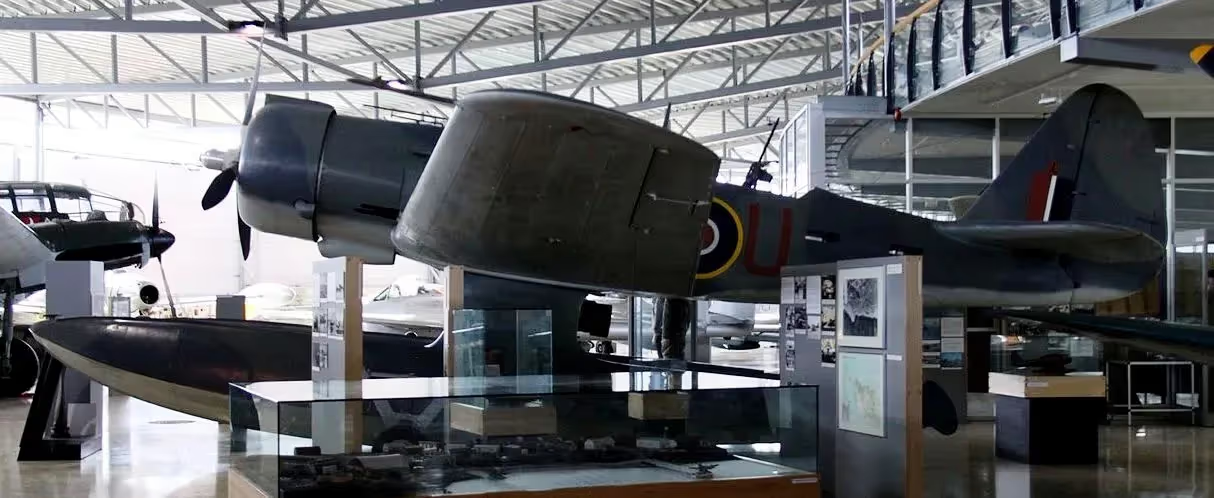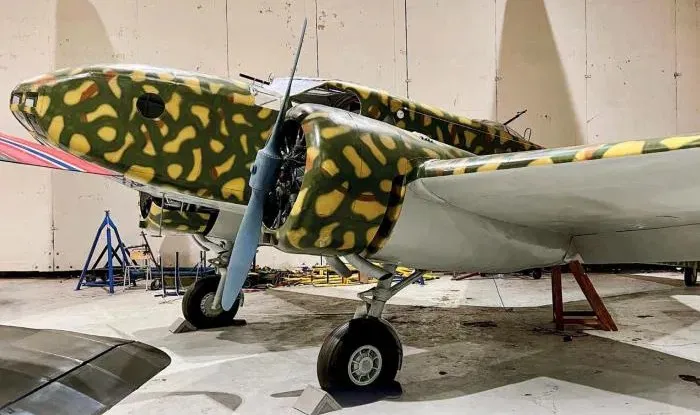Warplanes of Norway: Second World War aircraft preserved
Warplanes of the Second World War preserved in Norway
The aim of this website is to locate, identify and document Warplanes from the Second World War preserved in Norway. Many contributors have assisted in the hunt for these aircraft to provide and update the data on this website. Photos are by the author unless otherwise credited. Any errors found here are by the author, and any additions, corrections or amendments to this list of Warplane Survivors of the Second World War in Norway would be most welcome and may be e-mailed to the author at [email protected].
Krigsfly fra andre verdenskrig bevart i Norge
Målet med dette nettstedet er å lokalisere, identifisere og dokumentere krigsfly fra andre verdenskrig bevart i Norge. Mange bidragsytere har bistått i jakten på disse flyene for å gi og oppdatere dataene på dette nettstedet. Bilder er av forfatteren med mindre annet er kreditert. Eventuelle feil som er funnet her er av forfatteren, og eventuelle tillegg, rettelser eller endringer i denne listen over Warplane Survivors fra den andre verdenskrig i Norge vil være hjertelig velkomne og kan sendes til forfatteren på [email protected].
Norway (Quisling regime)
In Norway, the national government, headed by Vidkun Quisling, was installed by the Germans as a puppet regime during the occupation, while King Haakon VII and the legal government were in exile. Quisling encouraged Norwegians to serve as volunteers in the Waffen-SS, collaborated in the deportation of Jews, and was responsible for the executions of members of the Norwegian resistance movement. About 45,000 Norwegian collaborators joined the pro-Nazi party Nasjonal Samling (National Union), and some police units helped arrest many of Norway’s Jews. However, Norway was one of the first countries where resistance during the Second World War was widespread before the turning point of the war in 1943. After the war, Quisling and other collaborators were executed. Quisling’s name has become an international eponym for traitor. (Wikipedia)

(Library and Archives Canada Photo, MIKAN No. 3191644)
Pilot trainees with Curtiss Hawk 75-A8 fighters at the Little Norway training centre, Toronto Island, Ontario, Canada, April 1941.
Norway ordered 24 Twin Wasp-powered Curtiss Hawk 75A-6s, of which 19 were delivered and seven assembled at the time of the German invasion. None of the aircraft were combat-ready. The disassembled aircraft were disabled by a single customs employee who smashed the instruments and cut all the wires he could reach. Thirteen Norwegian Hawks captured by the Germans were part of the first batch of 29 P-36s sent to Finland. Norway also ordered 36 Cyclone-powered Hawk 75A-8s. Most of this batch (a total of 30) were delivered as advanced trainers to "Little Norway" near Toronto, Ontario, Canada, a Norwegian training base established by the London-based government-in-exile. Still later, they were resold to the U.S. and redesignated the P-36G model.

(Library and Archives Canada Photo, MIKAN No. 3204129)
Mechanics servicing P-36 fighters at Little Norway, Ontario, April 1941.

(Library and Archives Canada Photo, MIKAN No. 3199027)
Northrop Nomad trainers on the line at the Little Norway Training Centre for Norwegian Air Force, Ontario, 8 Nov 1940.

(Library and Archives Canada Photo, MIKAN No. 3204130)
Norwegian Instructor and Senior Norwegian Officer laughing at a small mascot carried by a Fairchild PT-26 Cornell at the "Little Norway" Training Centre Flying Field, Ontario, c1941.

Little Norway, 1 November 1940 (Royal Norwegian Air Force training facility in Toronto, Canada. In total during the war, over 2,500 Norwegian airmen of all categories (pilots, navigators and mechanics) were trained in the various bases of "Little Norway". (Archives of Ontario Photo C109-2-0-18)
Backgrounder to Little Norway
By Chris Charland, Senior Associate Air Force Historian, Canada
Around 1000 A.D. Vikings first set foot upon the shores of Canada's east coast. In 1940 they were back but not by choice. On 9 April 1940, Norway like most of Europe, was overrun by Herr Adolph Hitler's Wehrmacht and Luftwaffe. The Norwegians fought a valiant and ferocious battle exacting a heavy toll but continued to lose ground to the Nazi juggernaut. Eventually organized resistance was effectively crushed. Scores of Norwegian men escaped from the clutches of tyranny in whatever fashion they could muster. Many of them after long round about journeys, ended up in Canada at a flying training facility on Toronto Island Airport dubbed Little Norway.
The Norwegians flew a mixed bag of aircraft from the island airfield which included Curtiss 75A-8 Hawk fighters, Fairchild PT-19/PT-19-FA elementary trainers and Douglas 8-AF attack bombers and the Stinson SR-5. By the spring of 1942, the Norwegians found themselves running out of available space with the influx of new recruits. As well, it was deemed too dangerous to conduct any further pilot training due to the close proximity of large buildings downtown and an expanding urban population. The answer to their problems lay up the road at the Department of Transport's Muskoka emergency airport. The facility was constructed shortly before the outbreak of the Second World War. During the early days of the war, Muskoka had been temporarily used by the RCAF conducting flying training on the Avro Anson, North American Yale and its bigger brother the Harvard. The Norwegians were no strangers to the area. Funds donated by members of the Norwegian air services helped pay to build a large recreational facility at Oxbow Lake. It was named Vesle Skaugum after the Oslo residence of Crown Prince Olav. Upon signing a lease agreement with the D.O.T., Norwegian flying operations at Toronto Island Airport ceased, and Little Norway was subsequently moved lock stock and barrel to their new wilderness setting.
From the summer of 1942 through to the closure of Little Norway on the 16th of February 1945, pilot training was conducted on the Canadian license-built (Fleet Aircraft of Fort Erie, Ontario) Fairchild PT-26-FA and PT-26B-FE. These aircraft were known by their British name of Cornell Mk. I and Mk. II respectively. Prince Olav, the exiled Crown Prince of Norway and his wife Princess Martha, officially opened the new Little Norway on 4 May 1942. From here, fledgling Viking pilots would slip the surly bonds in hopes that they might help with the liberation of their country someday soon. Since then, Canada and Norway have enjoyed a unique and special relationship that will endure for ever.
Aircraft flown by the RNAF while training in Canada during the Second World War included:
Army
Fairchild M-62éPT-19 and PT-26 Cornell.
Douglas 8A-5/A-33.
Curtiss Hawk 75-A8.
Naval Air Corps
Noorduyn Norseman.
Stinson SR-9 Reliant.
Northrop N-3PB.
Norwegian Aviation Museum (Norsk luftfartsmuseum), Bodø, Nordland.
Consolidated PBY-5A Catalina (BuNo. 46645).
de Havilland DH.82 Tiger Moth (Serial No. 88210).

(TSRL Photo)
de Havilland DH.98 Mosquito T Mk. III (Serial No. TW117).
Fairchild PT-19 Cornell (Serial No.).
Focke-Wulf Fw 190A-3/U3 (Wk. Nr. NR 2219), Black 3.

(Towpilot Photo)
Fokker C.V-D (Serial No. 349).
Hawker Hurricane Mk. II, replica.
Junkers Ju 88A-4, 4D+AM, displayed as crashed.
North American T-6/J Harvard (Serial No. 52-8570).
Petlyakov Pe-2FT (Serial No. 16/141), cockpit section, Soviet light bomber.
Supermarine Spitfire LF Mk. IXe (Serial No. MH350).
Notodden, Norwegian Flying Aces

(Norwegian Flying Aces, Jan Erik Arud Photo)
Boeing Stearman.

(Norwegian Flying Aces, Jan Erik Arud Photo)
North American Harvard.

(Norwegian Flying Aces, Jan Erik Arud Photo)
Supermarine Spitfire F Mk. IX (Serial No. EN570), coded FY-J, Reg. No. LN-AOA, converted to two-seater by Biggin Hill's Spitfire Factory. Airworthy as of 22 April 2024. Notodden, Norwegian Flying Aces. Previously with No. 611 Squadron RAF, shot down over northern France on 11 June 1943, with the loss of F/O Gordon R. Lindsay. To be ferried to Norway.
Norwegian Armed Forces Aircraft Collection (Forsvarets flysamling Gardermoen), Gardermoen, north of Oslo.
Auster (Taylorcraft) J/1 Autocrat, representing type of aircraft used by No. 132 (Norwegian) Wing, No. 331 Squadron and 331 Squadron, RAF Fighter Command, based in the UK and on the Continent during the Second World War. The museum's example is an ex-civil composite.


(Clemens Vasters Photos)
Douglas C-47A Skytrain.

(aeroprints.com Photo)

(Pål Næss Photo)
Fairchild PT-19 (Serial No. 103). This aircraft came in three versions, PT-19, PT-23, and PT-26. PT-19 and PT-26 were used by the Norwegians, first at the training base Little in Canada from August 1940 and later in Norway until 1957. The museum's PT-19 is one of the first batch of six such trainers entering service in August 1940.

(aeroprints.com Photo)

(Pål Næss Photo)
Fairchild Cornell M-64 (Serial No. 205).
Heinkel He 111P-2, built in 1938. This aircraft served with Kampfgeschwader 4 after the invasion of Norway in April 1940 and made emergency landing at Digervarden after combat with two Fleet Air Arm Blackburn Skuas on 26 April 1940. It was recovered in 1976 and restored at Gardermoen.
Heinkel He 111 P-2 (Wk. Nr. 1526), built in 1939.
Interstate S.1A Cadet. Used at Little Norway in Canada during the Second World War, this aircraft came to Norway in 1945. Wreck donated to NAHS in 1970 and later restored by society members.
Junkers Ju 52/3m-g4e. One of 13 aircraft used for carrying a battery of mountain artillery to German forces in the Narvik area on 13 April 1940. This aircraft landed on the frozen lake Hartvikvatnet and later sank through the ice. It was recovered in 1983 and restored at Gardermoen.
Junkers Ju 88C-2. This aircraft made an emergency landing at Nonsfjellet in May 1940. It was recovered in 1990 and is being used for spares in the restoration of the Ju 88A-1.
Junkers Ju 88A-1 (Wk. Nr. 088119), U4+TK. German bomber, served with Kampfgeschwader 30 during the invasion of Norway in April 1940, landed on the frozen lake Jonsvatnet near Trondheim on 20 April 1940. Later sank and was recovered in 2004. Under long-term restoration in the museum's workshop.
Lockheed C-60A Lodestar. Transport used on the 'Stockholm run' between Leuchars in Scotland and Bromma near Stockholm in neutral Sweden during the Second World War. The museum's aircraft was not used on the route but is from the same production batch as Norwegian aircraft.
Noorduyn Norseman Mk. IV.

(Riksarkivet, NTB krigsarkivet Photo)
Northrop N-3PB Nomad.

(Riksarkivet, NTB krigsarkivet Photo)
Northrop N3P-B, No. 330 (Norwegian) Squadron, RAF, based at Akureyri, Iceland, in flight over the North Atlantic Ocean.

(IWM Photo CS 92)
Northrop N3P-B, 22, GS-F, No. 330 (Norwegian) Squadron, RAF, based at Akureyri, Iceland, in flight over the North Atlantic Ocean.

Northrop N3P-B, No. 330 (Norwegian) Squadron, RAF, taxis out on the water at Akureyri, Iceland, for a patrol. One of the aircrew is standing on one of the floats to check the running of the engine, 1 May 1942. (IWM Photo CS 219)

Northrop N3P-B, No. 330 (Norwegian) Squadron, RAF, based at Akureyri, Iceland, Oct 1941. (IWM Photo CS 33)

(aeroprints.com Photo)

(Pål Næss Photo)
Northrop N-3PB. This unique aircraft served with No 330 squadron in Iceland from 1941 to 1943. In April 1943 it encountered bad weather on a flight from Budareyri to Reykjavik and crashed in the river Þjórsá. It was recovered in 1979 and restored by Northrop Inc in Hawthorne, California, the following year.


(Clemens Vasters Photos)

(aeroprints.com Photo)
Supermarine Spitfire PR Mk. XI (Serial No. PL979), A-ZB, flown by the RNoAF from 1947 to 25 March 1954, when the last flight by a Spitfire in Norwegian service was carried out by Second Lieutenant Amund Klepp in this aircraft.

(Royal Norwegian Air Force Photo)
Supermarine Spitfire LF Mk. IXc (Serial No. JL361), A-CD (later FN-D/AH-D). This aircraft was the oldest of the Spitfires brought to Norway, being initially built as a Mk VC, it was transferred to Rolls-Royce to be converted to one of the first of the Merlin 66-equipped LF IXc's in April 1943. Having spent its wartime service life as a test aircraft at Boscombe Down and Farnborough, it was one of the Spitfires bought in 1947 to equip a third fighter squadron but subsequently used as replacement aircraft for the two existing units. Codes are white, spinner grey (as upper camo), serial on fin black.
Supermarine Spitfire Mk. IX full-scale fibreglass replica hangs under the ceiling.
Flyhistorisk Museum, Stavanger Airport, Sola.

(Manxruler Photo)

(Ramon Van Opdorp Photo)
Caproni Ca.310 bomber. One of four that served with the Norwegians. It was left behind in the village of Oye during the German invasion in April 1940. The remains were discovered in 1992.

(Tormod Løkling Photo)
Caproni Ca.310 Libeccio (South-westerly wind) bomber. This is the only one still exising. One of four acquired by the Norwegian Army Air Service (NAAS) in Oct 1938, it was stationed at Sola. Nicknamed the "Clipfish Bomber" (because it was paid for with revenues from clipfish exports to Italy). This was the first monoplane in the NAAS, its first twin-engined aircraft, first with retractable landing gear, first with a radio and first with pitch control. The German blitz ended its NAAS service on 9 April 1940. (Tormod Løkling)



(Alan Wilson Photos)
Consolidated PBY-5A Catalina (BuNo. 08109), (Serial No. 382), c/n 928. KK-A, (actually RDAF (Serial No. L-857). Delivered to Royal Danish Air Force in 1951 and became FM-57, later renumbered as 82-857 and finally as L-857. Retired in 1967, she remained stored and stripped at Vaerlose AirBase until moving to Sola for restoration in 1989. She is now painted to represent an aircraft of No. 333 squadron, Royal Norwegian Air Force. It is on display at the Flyhistorisk Museum, Sola, Norway.
Fairchild PT-26 Cornell, being restored.
Luftwaffe aircraft:
Arado Ar 66, being restored.
Arado Ar 96.
Arado Ar 196.
Fieseler Fi 156 Storch.


(Alan Wilson Photos)
Heinkel He 115, in conservation. During the Second World War the water adjacent to what is now Sola airport was used as a seaplane base by the Luftwaffe. On 28 Dec 1942, a Heinkel He115 of Luftflotte 5 (Wk. Nr. 2398), coded 8L+FH, crashed and sank while landing. In 2006 the intact remains of the aircraft were located and in June 2012 they were raised and recovered. Except for the floats and the starboard engine the aeroplane was complete and everything recovered was extremely well preserved. It is now under restoration by the Flyhistorisk Museum Sola with the cockpit and nose section being used as a mobile exhibit. Original markings are clearly visible, showing the level of preservation.
Messerschmitt Bf 109 G-2/R1 (Wk. Nr. 13470), ex-CI + KS, ex-8./JG 5 "White 4", being restored, Norwegian Aviation Museum, Bodø.
Messerschmitt Bf 109 G-1/R2 (Wk. Nr. 14141), ex-DG + UF, ex-2./JG 5 "Black 6", being restored, Flyhistorisk Museum, Sola.
Messerschmitt Bf 109 G-2/R-6 (Wk. Nr. 14649), Stab IV/JG 5, "Yellow 3", being restored, Norwegian Aviation Museum.

H.M. King Haakon VII of Norway (at Embassy) London sitting, ca Nov 1943. (Library and Archives Canada Photo, MIKAN No. 4731267)





